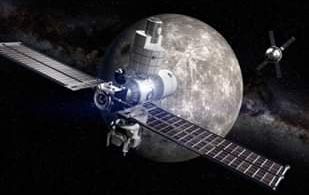Click on photo to start video.
Space station around the Moon!! But when and how?? Watch yourself!! #MoonExploration #SpaceExploration

Click on photo to start video.
Space station around the Moon!! But when and how?? Watch yourself!! #MoonExploration #SpaceExploration

“Planet Earth Report” provides descriptive links to headline news by leading science journalists about the extraordinary discoveries, technology, people, and events changing our knowledge of Planet Earth and the future of the human species.
The Universe Might Be Too Thin, Scientists may have found a new crack in our understanding of the universe, reports The Atlantic and Quanta. The cosmos is starting to look a bit weird. For a few years now, cosmologists have been troubled by a discrepancy in how fast the universe is expanding. They know how fast it should be going, based on ancient light from the early universe, but apparently the modern universe has picked up too much speed—a clue that scientists might have overlooked one of the universe’s fundamental ingredients, or some aspect of how those ingredients stir together.

EXCLUSIVE: Following the success of SpaceX’s Crew Dragon mission, which marked the return of the U.S.’ capability for manned flights and the first private company to get people into orbit, a reality series wants to send a civilian into space.
Space Hero Inc., a U.S.-based production company founded by Thomas Reemer and Deborah Sass and led by former News Corp Europe chief Marty Pompadur, has secured a seat on a 2023 mission to the International Space Station. It will go to a contestant chosen through an unscripted show titled Space Hero. Produced by Ben Silverman and Howard Owens’ Propagate, the series will launch a global search for everyday people from any background who share a deep love for space exploration. They will be vying for the biggest prize ever awarded on TV.


Over the past five decades, space travel advocates have been pushing to expand our footprint in space. They dream about lunar bases, missions to Mars and colonies in free space. The visions are ever changing, with government efforts joined by those of private companies like Elon Musk’s SpaceX — in the midst of an effort to send tourists on a trip around the Moon — gravitating toward the space tourism sector. While the goals and how to accomplish them are in constant flux, there remain certain obstacles that must be overcome before we take that next big step. And one of the biggest is the need to protect the health of our future space explorers.
That’s what’s prompted NASA to turn to the fast-moving world of gene therapy to solve several potential medical issues facing astronauts on lengthy space missions.
The US space agency and the associated Translational Institute for Space Health Research (TRISH) at the Baylor College of Medicine are now calling for proposals from private companies and other groups to develop a kind of gene therapy for astronauts. But this would be different than recent gene therapies that target specific diseases such as hemophilia or various types of cancer. Instead, the idea here is to minimize the damage from space radiation through a kind of preventive treatment. Exposure to radiation in space can cause cancer, cardiovascular disease, cataracts and the loss of cognitive function due to accelerated death of brain cells. These different disease categories involve very different mechanisms — cancer and heart disease result from radiation damaging DNA, while loss of brain tissue results simply from radiation killing off mature cells, and still other diseases result from radiation destroying stem cells.

@BlueOrigin, @DraperLab, @NorthropGrumman & @LockheedMartin have completed critical System Requirements Review (SRR) for their #NationalTeam Human Landing System (HLS) concept.



Blue Origin’s human lunar lander all-star space team completes first key milestone for moon mission – TechCrunch.
Blue Origin, along with it partners Lockheed Martin, Northrop Grumman and Draper, was one of three companies to be awarded contracts by NASA to develop human lunar landers for future moon missions. Blue Origin’s so-called “National Team” is focused on developing a Human Landing System (HLS) for NASA to support its efforts to return human astronauts to the surface of the moon by 2024, and today it announced that along with its partners, it has achieved the first crucial step of defining the requirements of the mission, including any space and ground vehicles used.
This is a key first step, which amounts to having established a checklist of thousands of items that will make up the parameters of the National Team’s HLS mission. It means that the company can now move ahead to further NASA reviews (it has already agreed with the agency on a number of the proposed design and build standards) and ultimately, the preliminary design phase.
Blue Origin and its partners won’t be starting from scratch with their design, which is one advantage to the Bezos –founded space company working with established industry partners like Lockheed, Northrop and Draper. They’re “evolving” much of their landing system design from existing spacecraft including Orion, the reusable spacecraft that will take NASA’s astronauts from Earth back to the moon via the Artemis program, which was built in part by Lockheed Martin.